Introduction
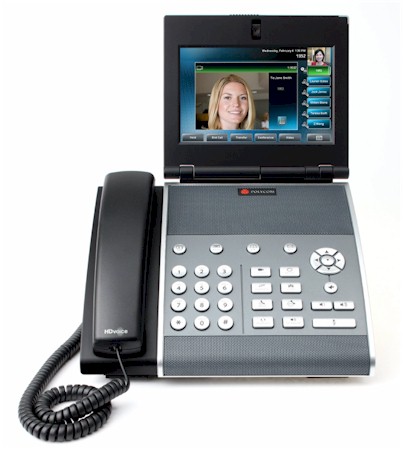
| At a Glance | |
|---|---|
| Product | Polycom Business Media Phone (VVX 1500) |
| Summary | Small business SIP video phone with great audio and video quality using relatively low bandwidth |
| Pros | • Outstanding voice quality • Touchscreen display eases phone setup & use • Most capable XML micro-browser of any Polycom phone • Superb speakerphone • Easy, reliable video calling over IP |
| Cons | • Expensive • Limited number of supporting ITSPs • Video frame size limited to CIF/SIF • Limited interoperability w/ other videophones/soft phones • Physically larger than most other IP phones |
A little over a year ago, I was offered the daunting task of reviewing the Polycom Soundpoint IP550 & IP650 desk phones. It was a considerable challenge being tasked with the review of these top-of-the-line products from a company that is considered by many to be a market-leader in enterprise VoIP.
Well, that review was easy compared to my current task of evaluating one of their newest offerings; the VVX-1500 Business Media Phones. I almost wish that I hadn’t agreed to undertake the project, because these devices have a wealth of features. But here I am, having had the phones for a couple of months. So I thought I’d best make good on my promise to describe these beasties in some detail.
The VoIP landscape is littered with consumer videophones that failed to deliver or even have a significant impact on the market. A few companies like D-Link, Motorola (Ojo) and Vialta have offered hard phones while others have tried a soft phone (software-based) approach. Neither approach has been able to generate positive consumer buy-in.
Even Skype, the dominant player in the space, reports that only about a third of its call volume includes video. So it’s safe to say, that consumers just don’t see much value in video calling. But, the same cannot be said for businesses that are looking for ways to economize on business travel, both to help the bottom line and reduce carbon footprint.
With this in mind, VoIP manufacturers are bringing forth a new wave of video capable devices targeting business applications. It’s this business-centric focus that might make the difference in whether people find value in its capabilities. The Polycom VVX-1500 is part of this new lineup. Some would refer to the VVX-1500 as a “videophone” but that’s a little too simplistic. Polycom calls the VVX-1500 a “Business Media Phone” but that’s very vague.
Features
The Polycom VVX-1500 is a SIP phone with numerous multimedia features. At its core, it’s an IP phone not unlike the SoundPoint IP650 that I reviewed last year. In fact, they run the very same firmware. But the VVX’s feature set is truly a superset of the IP650’s.
The VVX’s design is similar to its lesser siblings in the Polycom SoundPoint lineup, but with some significant differences. The most obvious is the addition of a 7-inch wide-screen color TFT touchscreen LCD display. The display is mounted in a fashion that gives the phone a kind of large clamshell appearance. The display is hinged and folds down over the speaker & dial pad for shipping and storage (Figure 1).
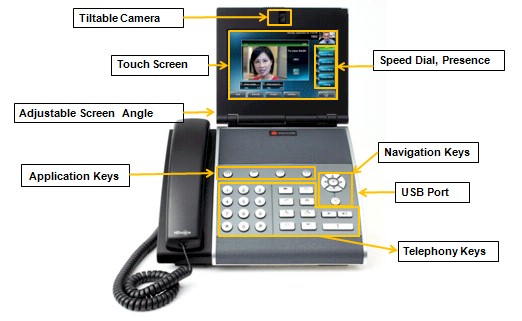
Figure 1: VVX Features
A small video camera is mounted in the top of the LCD display. The camera can be adjusted vertically without the need to disturb or adjust the position of the LCD display. The TFT LCD display in the VVX-1500 is looks good. It’s vibrant and sharp, with good brightness and contrast. Of course, the LCD display is a key component in making video calls, but the phone leverages it in other ways as well.
For example, the VVX-1500 features a “Picture Frame” mode that turns the display into a digital photo frame while the phone is idle. It also provides an enhanced display for the built-in XML micro-browser.
The VVX-1500 has all the normal external connections (Figure 2). The handset and headset connections are via RJ-9 connectors. The phone has dual Gigabit Ethernet connections so that it acts as a 2-port switch. Thus one network drop can service both the VVX-1500 and a PC at the users location. A coax connector supports directly powering the phone with 48 VDC, although I expect most people would power the device using power-over-Ethernet.
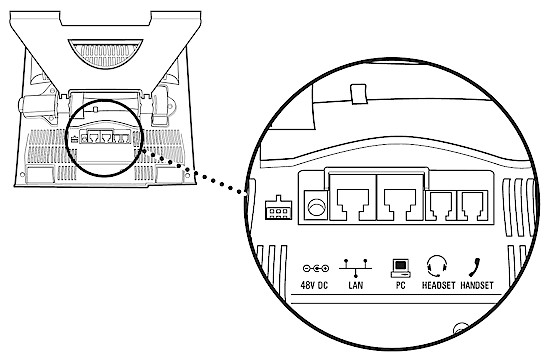
Figure 2: VVX Connector panel
Unlike the SoundPoint phones, the stand on the VVX-1500 is height adjustable, which is similar to Cisco 79xx series phones. Set at its lowest, the phone takes the most desk space but has a reasonably low profile. With the stand set higher, the phone stands quite tall on the desk. This provides a way to position the camera height so that it’s not necessarily looking up at you. The stand folds flat against the back of the phone for shipping. I also expect that the phone could be wall mounted if a suitable bracket were offered.
Some users may feel that the phone is a little bit large for their desktops. This is exacerbated by locating the USB port behind a small door on the right side of the phone. If you use the USB port a lot you’ll likely have the memory key effectively increasing the phones footprint on your desk. It would have been nice if the USB port could have been located on the back of the device, but tucked out of the way of the stand.
The resistive touchscreen is fairly responsive, but I found that my fingers were a little too large to type quickly using the touchscreen keyboard layout. I suspect that some people might prefer to use a stylus rather than their fingertip for such entry tasks. Polycom indicates that this is possible in their documentation, but a stylus is not provided.
The buttons on the VVX-1500 are a larger than the buttons on the SoundPoint series phones, and have a metallic feel to them. The major function keys on the phone are internally backlit by blue LEDs when the related function is active.
Polycom paid particular attention to power consumption in the VVX-1500;s design, since it draws a very modest 11 W. It also supports 802.3af standard power-over-Ethernet, declaring itself a class 0 device to the upstream switch. When not on a call, the phone uses the camera to sense movement, and turns off the backlight on the LCD display if it senses that no one is nearby. In this off-hours or standby mode, power consumption drops to just 6 W.
Setup
Previous Polycom phones have been notoriously tedious to setup. But the touchscreen display makes setting up the VVX much easier. Like other SoundPoint phones, basic network settings are established directly on the phone as it boots. From that point, you can use a web browser to access the phone’s administrative web portal and set up various SIP settings. Then, instead of navigating menus with five direction keys, you simply tap on the desired menu option right on the LCD. The on-phone menus allow access to all the settings necessary to get the device on your network and interacting with a SIP server. I found this a very intuitive way to set up the phone’s most basic network settings.
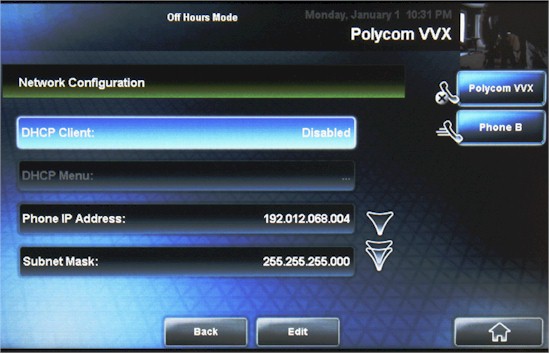
Figure 3: On screen network configuration
With only two VVX devices under evaluation, I configured the phones using just the on-phone menus in conjunction with the touchscreen. This was fast and easy. But if I were rolling out a number of these devices, I’d provision them using a central server as described in last year’s review of the IP650. The VVX-1500 supports provisioning via TFTP, FTP, HTTP, HTTPS or SFTP. If you already have some Polycom phones in your company, then the VVX will fit right into your existing provisioning arrangement.
In Use
Polycom provided me with a self-contained demo package that included a pair of VVX-1500, a NETGEAR switch with POE capability, all the necessary cabling and a USB Kingston Traveler memory stick. This type of demo kit is what they would typically deploy to a small trade show where Internet access was not available. The phones had fixed IP addresses and preset contacts that corresponded to the other phone, making it easy to call from one to the other without even a SIP registrar.
Given this demo configuration, for the first few days I had both phones in my home office and made video calls from one end of the office to the other. From even this most basic experience, I learned a few things about the VVX. For example, the VVX supports multiple wideband codecs, including; G.722, G.722.1 and G.722.1C. That means that it was completely interoperable with my IP650s, which support G.772 based 8 KHz wideband audio capability. Beyond that, they should be interoperable with larger conferencing systems that typically support the two additional wideband codecs.
I also found that between the two VVX units, I could use G.722.1 (aka Siren7), which delivers the wideband call quality of G.722, but at a much lower network bitrate. It requires only 24-32 Kbps, considerably less than even a plain vanilla POTS call using G.711, which is 64 Kbps.
Finally, G.722.1C (aka Siren14) delivers what some call “Super-wideband” audio. Its sampling rate of 28 KHz delivers a usable passband of around 14 KHz, or just about equal to the best FM radio you’ve ever heard.
Beyond the codecs, the VVX hardware is able to deliver superb call quality. The handset is sturdy, with none of the creakiness often found in cheaper hardware. I was surprised to find that the VVX speakerphone is markedly better than my existing SoundPoint IP650s, and comparable to the IP6000 dedicated speakerphones that we use in our corporate conference rooms.
Of course, making use of wideband telephony typically means passing over an end-to-end IP network. The basic setup of the demo setup delivered IP calling on a dedicated LAN so wideband calling was easy. The VVX units were set to automatically start sending and receiving video if the other end of the call was suitably capable. Between the two demo units this was perfect every time. The video was crisp and quick.
The clamshell design allows you to adjust the tilt of the LCD display and camera for optimal viewing. The camera is also independently adjustable so that it can get a well-framed shot when you are directly in front of the phone. A privacy shutter physically disables the camera for times when a video call would be unwanted.
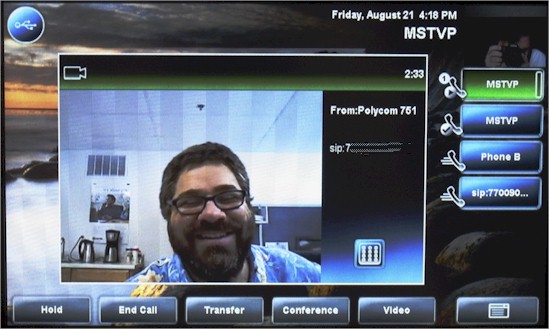
Figure 4: Video call in progress
With two sets of terrace doors, my home office is well lit during the day. This can present a challenge to a videophone or webcam since there is often a bright light source directly behind me. The VVX phones seemed to handle this situation reasonably well.
The VVX-1500 supports two common video frame sizes, both at frame rates up to 30 fps:
- CIF (Common Intermediate Format) = 358×288 pixels
- SIF (Source Input Format) = 358×240 pixels
The phone is able to encode the video streams using H.263, H.263+ (1998) or H.264, which are all standard video codecs for this application. While these are not especially high, resolution is comparable to larger video conferencing systems and CIF and SIF are industry standards that should permit some degree of interoperability with larger boardroom systems.
At present, the VVX-1500 supports the SIP protocol for both audio and video applications. In contrast, many existing video conferencing systems use the older H.323 protocol. Polycom tells me that a coming firmware release will be “dual stack” capable supporting SIP and H.323 simultaneously. This will give the VVX-1500 outstanding utility as an end-point for home office workers who need to participate in video conferences with larger boardroom systems.
I tried some rudimentary interoperability testing using Eyebeam v1.5 and the newly released LifeSize Desktop video conferencing client. Voice calls between Eyebeam and the VVX phones were excellent, with no interoperability issues. However, I was not able to get video calls working with that pairing. Voice calls between the VVX-1500 and LifeSize Desktop were outstanding. This in part because both implement G.722.1C, delivering what the telephony world is now calling “Superwideband,” with high-frequency response up to 14 KHz.
As was the case with Eyebeam, I could not get video calls to work between LifeSize Desktop and the VVX-1500. It appeared that they almost worked, but when the video stream was being set up the VVX would display one frame and then reboot. While they use the same video codec (H.264) I suspect that the major trouble was the video frame dimensions. Although the VVX-1500 supports CIF or SIF frame sizes, the LifeSize Desktop software streams video in the native size of the webcam that it’s using as a video source. It offers no means to resizing the video to a specific size.
The bottom line is that my older Logitech Fusion webcam with LifeSize Desktop was sending 640×480 pixel frames that were simply unsuitable for the VVX-1550. The VVX unit actually displayed the first video frame, then paused and rebooted. While this sounds bad, it is in fact a very good sign. I expect that interoperability with other SIP devices using H.264 encoded CIF/SIF size video would be possible.
Calling from one of the room to the other became boring pretty quickly, so I eventually set up both phones with credentials on my Junction Networks OnSIP hosted IP-PBX account. Both phones registered easily, just as if they were more typical IP phones.
With the phones now registered with an out-of-house SIP server, I could make normal calls to the PSTN and wideband calls to various G.722 capable phones that I have deployed around my employer’s various locations. We have a mix of Polycom, Gigaset and snom gear installed, as well as Counterpath’s Eyebeam 1.5 and the freeware PhonerLite soft phones. I experienced literally no interoperability issues with the VVX phones with respect to voice functionality. All of the usual calling features like hold, transfer, conference, join & split conferences, etc. worked as expected.
The fact that the demo suite included a Kingston USB memory stick suggested that the phones had been licensed with the optional Polycom Productivity Suite. This software option was also described in the IP650 review. I have this on several of the phones that I use every day. While the productivity suite comprises a number of features, I especially appreciate the ability to instantly start recording a call to a WAV file on the USB key. I have found this invaluable to supplement taking notes during a conference call. People who might have missed the call can later listen to the recording and glean more than what my written notes might convey. However, I was not able to find the menu options that expose the Productivity Suite options on the VVX.
In placing calls between the two in-house VVX units, the video capabilities were engaged by default, even though both phones were now registered with OnSIP. Since OnSIP does not proxy the call media, the RTP streams for video and audio did not traverse my router. The phones simply negotiated between themselves and settled upon mutually acceptable video and audio settings. Almost magically, a video call ensued. No special setup required.
Test Call
Early in August and out of the blue, I received a message from another VVX user who was also a new customer of OnSIP. He asked that I try making a test call to his SIP URI. Dialing his SIP URI into my VVX-1500 I made the call and was happy to find that we had a video call, and also outstanding wideband audio. This was my first experience passing a VVX video call to the world beyond my local network.
Once the call was underway, I looked at the management console for my router and found that the VVX phone was passing about 500 Kbps in each direction, although Polycom specifies that video+audio can consume up to 768 Kbps. On screen the video was clear and smooth, showing the full 30 frames/second. And the video quality was surprisingly good. With the help of Chris Veazey from BlinkMind, I recorded the following short video to show how good the call quality is with such little bandwidth.
In the weeks since, a few other people with VVX-1500 phones have called me. Most were just getting the devices set up and needing to test them by calling an out-of-house SIP URI. Fellow VoIP blogger Dave Michels (http://www.pindropsoup.com) called me while in the process of setting up an evaluation of the VVX-1500 with a Mitel IP phone system. At no time in using the VVX-1500, did I ever experience the loss of sync between the audio and video. This is a classic problem that I have often encountered with video capable soft phones.
While a video call is in progress you can toggle video display modes. The remote party’s video stream can be displayed in a window on the LCD or zoomed up to almost the entire screen. Your outgoing video always remains in a small window in the upper right corner of the screen.
You can also access the phone’s various menus while a video call is active. Your view of the remote party goes away momentarily, but they still see your stream. Hitting the “Home” soft button returns you to the default display with of both video streams.
Dialing By SIP URI
Of course, you’re not usually going to be making wideband or video calls via the normal phone numbers (aka the PSTN.) To ensure a pure IP call path, it’s becoming more common to make calls by way of SIP URI, which look very similar to an email address.
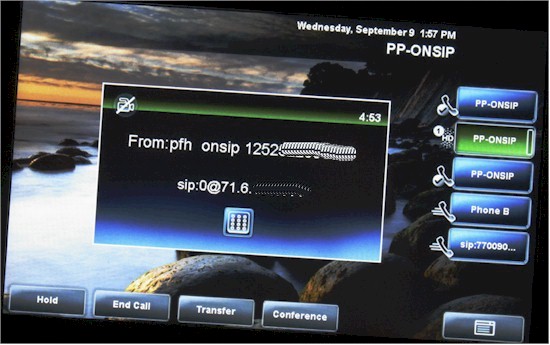
Figure 5: SIP URI
Using a SIP URI implies that, beyond the typical dialpad, you have some way to perform alphanumeric entry into the phone. The Soundpoint series of phones have long had a way of entering SIP URI via the dialpad, but it’s more than a little tedious. Most users get around this by entering the SIP URI that they commonly use into the phone’s contact directory. Since the contacts can be provisioned remotely from an XML file, this saves manually entering complex alphanumeric sequences directly on the phone.
In contrast, the VVX-1500 provides nice tools for using SIP URIs. When dialing, you can select either a traditional dialpad display on the LCD or a soft QWERTY keyboard layout. With the dialpad display selected, you can dial using the hard keys or by touching the soft keypad on the touchscreen LCD. Selecting the QWERTY layout on the LCD makes entering SIP URIs trivially easy, not unlike using the virtual keyboard on an iPhone or Blackberry Storm.
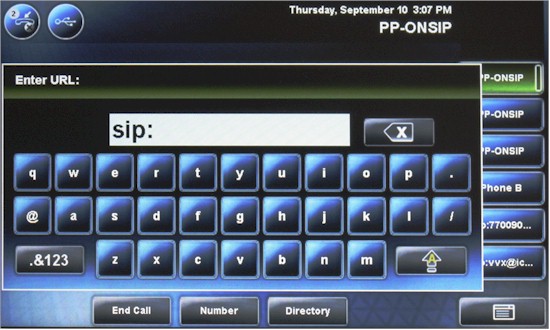
Figure 6: On screen keyboard
XML Browser & API
Beyond video calls, the next best use of the LCD display is the built-in XML micro-browser. Polycom has provided this capability in the Soundpoint series phones for some time, but the color touchscreen display makes it a much more attractive tool for corporate developers.
The XML browser can be used to display data relevant to a user’s working life. To illustrate the capabilities of the feature, Polycom has provided an online information service that they call “My Info Portal.”, which is accessed through the Applications menu. Once you establish a free login to this service, the VVX can be set to display a variety of data sources including;
- News top stories
- Sports top stories
- Weather conditions & forecast for a specific ZIP code
- Markets & Stock values for up to 5 listings
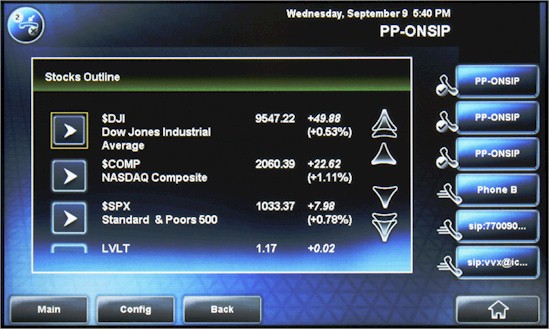
Figure 7: My Info Portal Stocks
Setting up the portal can be done from any web browser, or the phone itself. This service truly illustrates the potential of the XML micro-browser as a means of displaying live data to the user of the phone. In moving beyond this example I look forward to integrating a live view of a webcam pointed at my front gate.
The VVX-1500 also exposes an API allowing interaction with external systems. The API includes functions for many common call control processes. This allows tight integration of the phone into other corporate systems. For example, integration with a CRM system would allow click-to-dial functionality. In one click of the mouse, an outbound call could be placed and related customer profile data displayed on the VVX screen.
These sorts of features are the raw tools to support custom integration of the VVX-1500s into business processes. This is a phenomenon known as “Communication Enabling Business Processes” or CEBP.
Service Provider Partners
The VVX-1500 is on the vanguard of a new wave of high-end IP phone with multimedia capabilities. Polycom is working with a cadre of partners to ensure that telecom service providers are able to leverage the capabilities of the device. While that process is ongoing, the list of certified VVX-capable service providers is still relatively short, with service providers principally leveraging the Broadsoft Broadworks platform:
My own experience suggests that a truly open and SIP-compliant service provider can work well, even if they’re not on the list. Junction Networks / OnSIP works for me and they had no experience with the VVX-1500 before I told them that I was using it. However, some advanced features, like video voicemail, require that your service provider offer deep support for the VVX-1500. So before you make the investment in VVX-1500s, you should check with your intended ITSP to ensure device compatibility and depth of feature support.
For businesses that rely upon on-site PBX equipment, the VVX-1500 is certified as compatible with following list of IP-PBX systems:
- Adtran Netvanta 7100
- Epygi Quadro
- NEC Sphericall
- ObjectWorld Unified Communication Server
- Zultys MX 250
- Digium Switchvox
Closing Thoughts
It makes some sense that in evaluating the VVX-1500 we look at comparable competitive products to see where it fits into the marketplace. That’s not easy. In fact, if you want to compare it to truly similar devices it’s almost impossible.
To start with, there just aren’t that many video capable phones offered by anyone, anywhere. I’ve assembled a table below of the current offerings that I was able to locate online. On the low end of the scale, there are devices that target the home user and, to some degree, small businesses. These are the type of devices that have been offered by those how have pioneered videophone service, like 8×8.
| Make/Model | Grandstream GXV-3006 | Grandstream GXV-3140 | Motorola Ojo Phone | Polycom VVX-1500 | Cisco 7985G | Tandberg 150 MXP |
|---|---|---|---|---|---|---|
| MSRP | $249 | $299 | $350-$450 | $799 | $3945 | $2990 |
| Screen Size | 5.6” TFT LCD | 4.3”TFT LCD | 7” TFT LCD | 7” TFT LCD | 8.4” TFT LCD | 8.4” TFT LCD |
| Touchscreen | No | No | No | Yes | No | No |
| Wideband Audio Support | G.722 | G.722 | No | G.722, G.722.1, G.722.1C | G.722 | G.722 |
| Signaling Protocols | SIP | SIP | SIP | SIP H.323 (coming) | SCCP | H.323, SIP |
| Video Codecs | H.263, H.264 | H.263, H.264 | H.263, H.264 | H.263, H.263+, H.264 | H.261, H.263, H.263+, H.264 | H.261, H.263, H.263+, H.264 |
| Video Resolution | CIF / QVGA / QCIF | CIF / QVGA / QCIF | QCIF | CIF / SIF | SIF / QCIF / SQCIF | SIF / QCIF / SQCIF |
| Network interfaces | 2 x 10/100 | 2 x 10/100 | 1 x 10/100 | 2 x 10 / 100 / 1000 | 2 x 10/100 | 2 x 10/100 |
| Power-Over-Ethernet | No | No | No | Yes | Yes | Yes |
| Target market | SMB / consumer | SMB / consumer | Consumer | SMB / Enterprise | Enterprise | Enterprise |
Table 1: Video Phones Compared
Video Resolution Legend
CIF = 352×288 pixels
SIF = 352×240 pixels
QVGA = 320×240 pixels
QCIF = 176×144 pixels
SQCIF = 128×96 pixels
The trouble is that in some cases, low end video phones don’t have the kind of feature set that a more demanding business user would require. On the high-end, you have very expensive devices from Cisco and Tandberg. The have business class features and assured interoperability with similarly-branded conference suites. These devices, while very costly, just don’t seem as practical as someone’s everyday desk phone.
The Polycom VVX-1500 fits somewhere in the middle of these two groups. It’s definitely enterprise class hardware. It has the features, and build quality demanded of a business setting. It is, in essence, a solid desktop IP phone that is also a resource to the realm of larger videoconference systems. There is no doubt in my mind that the Polycom VVX-1500 is a fine piece of equipment, worthy of any executive’s desktop.
Setting aside the matter of video calling, it’s a superb SIP phone with a touchscreen LCD that can be very effective as a display for business related data, given a little effort on the part of your local IT team. But its ability to extend the video conferencing realm to include a single remote individual is what makes it a truly compelling device for mid-sized companies with existing video conferencing installations.
It’s application in smaller companies remains a little unclear to me, however. The idea of one-to-one video calls is just not as compelling as video conferencing in many cases. That use alone may not overcome the initial sticker shock of around $700, just for the phone!
My plan is to study the benefits of one-to-one video calling with a limited rollout of several VVX units to key staff. After a few months of use, we’ll then determine if one-to-one video calling brings real benefits to our business. If not, we will at least have some video capable phones that can integrate with our current plans for boardroom video conferencing.
